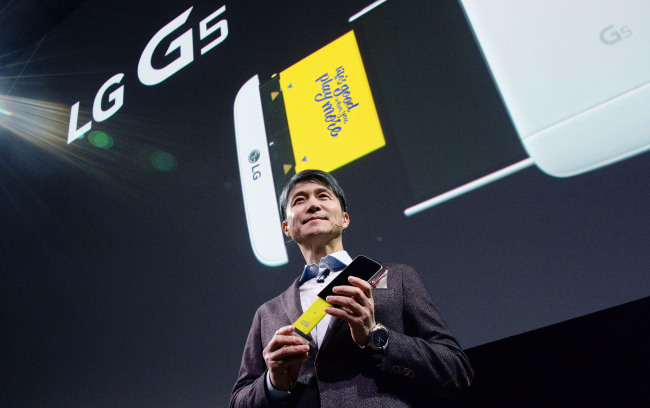[THE INVESTOR] LG Electronics and its display-making sister firm
LG Display are struggling to elevate the low yield rate of organic light-emitting diode panels that will be used for the Korean tech giant’s next flagship smartphone, tentatively called LG G6.
According to industry sources, the two firms are still gauging the new phone’s OLED adoption that industry watchers consider a must, rather than an option, for LG to remain a potent player in the crowded premium smartphone market.
“Even its Chinese rivals will be rolling out new phones equipped with curved OLED screens next year. LG will make all-out efforts to adopt its own,” said Yi Choong-hoon, chief analyst at UBI Research, a local research firm specialized on OLED.
 |
LG Electronics mobile chief Cho Juno poses with the company’s latest flagship G5 modular smartphone at the launch event held in February. |
LG says it is too soon to say about the G6 that is expected to be unveiled early next year. But related rumors are already piling up, especially on its possible OLED screen.
Currently,
Samsung Electronics, the world’s largest smartphone maker, uses OLED for almost 70 percent of its smartphones, including the flagship Galaxy S series and some lower-end models. With the planned adoption by Apple partially from next year, Chinese handset makers are also rushing to adopt OLED that is considered more flexible and energy efficient compared to conventional liquid-crystal displays.
Despite its leadership in OLED TVs, LG Display is a tiny player in the smartphone OLED market where Samsung Display boasts a whopping 97 percent market share. And the OLED adoption by LG phones has also been delayed.
LG Display, which has been supplying LCDs to LG, Apple and some Chinese handset makers, operates two OLED production lines in Paju, Gyeonggi Province, and Gumi, North Gyeongsang Province, respectively.
The Paju plant is focusing on orders from Apple. With some panels being supplied to Apple Watch 2, the company is beefing up production to supply OLED to the next iPhones possibly from 2018.
While Samsung has recently inked an exclusive deal with Apple to supply an annual 100 million OLED panels from the second quarter of next year for three years, LG hopes to be named a secondary supplier but its yield rate has yet to meet the iPhone maker’s strict criteria.
“LG has more than a year to prepare for Apple orders. But for the G6, it will be forced to make a strategic decision between OLED and yield losses,” an industry source said on condition of anonymity.
OLED panels for LG phones and other Chinese clients are expected to be produced at the newer Gumi plant. An OLED production system from Canon Tokki, a key equipment for OLED production whose supply is extremely limited, has recently been installed at the plant.
“Following the recent equipment installation, the plant will be able to start production from early next year. However, the yield rate remains an issue,” the source said. He predicted the full-fledged operations will start from later next year after another unit of the system is installed in the coming months.
The G6 comes at a crucial juncture for LG that has been struggling from sluggish sales of its more lucrative high-end smartphones, including the latest G5, the world’s first modular smartphone that comes with accessory modules to upgrade camera and audio functions.
It is unclear whether the G6 will succeed the modular concept. If LG fails to adopt OLED finally, industry watchers say there would be not many options for it to differentiate itself from rivals equipped with OLED in the market.
With its third-quarter earnings report scheduled to be released on Oct. 7, IBK Investment and Securities predicted the company’s operating profit in the July-September period will plunge 63 percent to 218 billion won (US$200 million) compared to a year ago, citing the money-losing mobile business division.
By Lee Ji-yoon (
jylee@heraldcorp.com)








![[Today’s K-pop] Blackpink’s Jennie, Lisa invited to Coachella as solo acts](http://res.heraldm.com/phpwas/restmb_idxmake.php?idx=644&simg=/content/image/2024/11/21/20241121050099_0.jpg)